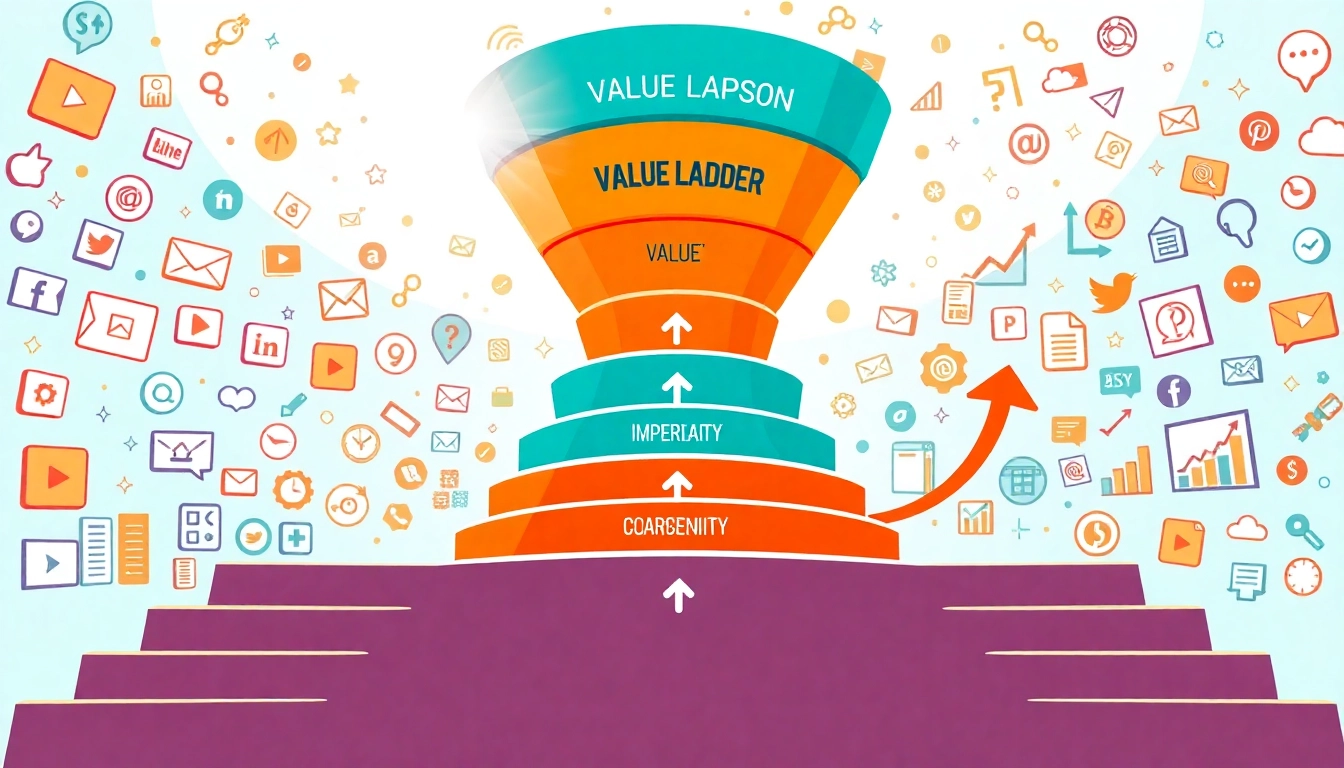Understanding the Value Ladder Concept
Definition and Importance
The Value Ladder is a powerful marketing framework popularized by Russell Brunson, which outlines the process of incrementally delivering value to customers through a series of products or services that increase in complexity and price. The underlying principle is simple yet profound: by providing various offers ranging from free to premium services, businesses can build trust, nurture relationships, and ultimately maximize customer lifetime value. This approach not only engages potential customers but also guides them seamlessly through their buying journey, making the Value Ladder an essential component of a successful Marketing strategy using Russell Brunson’s value ladder.
How It Works
The Value Ladder consists of multiple tiers, each representing a different stage of engagement with customers. The first tier usually begins with a bait—a free offer designed to attract interest. Progressing up the ladder, you move to lower-cost offerings (the Front End), then to higher-value items (the Middle and Back End), and finally culminate in the most premium products or services (The Peak). This structure not only facilitates upselling but also fosters a sense of community, as customers feel more invested in products that have consistently delivered value to them.
Benefits for Businesses
Utilizing the Value Ladder can yield numerous benefits for businesses, including:
- Increased Customer Loyalty: Providing value consistently fosters trust and encourages customers to stick around.
- Higher Average Order Value: As customers move up the ladder, their spending tends to increase, resulting in higher revenue.
- Better Market Understanding: The Value Ladder encourages businesses to identify various customer segments and tailor offerings accordingly.
- Enhanced Customer Experience: A well-structured ladder makes it easier for customers to find products that meet their evolving needs, leading to higher satisfaction.
Steps to Create Your Value Ladder
Identifying Customer Needs
Before constructing your Value Ladder, it’s crucial to understand your target audience deeply. This involves identifying their pain points, preferences, and buying behaviors. Utilize surveys, feedback forms, and direct interviews to gather insights from existing customers and prospects. Create customer personas that encapsulate the main characteristics and preferences of your audience segments. With this foundational knowledge in place, your value offerings can be designed to address specific needs effectively, positioning your products as the preferred solution.
Structuring Your Offers
Once customer needs are identified, it’s time to outline your Value Ladder. Each step should represent distinct offerings that provide increased value. A common approach includes:
- Bait: Free content, such as eBooks, webinars, or trials, to draw in prospects.
- Front End: Low-cost products that provide initial value and encourage a transaction.
- Middle: Higher-priced offerings that deliver significant value and engage customers further.
- Back End: Premium services or products that cater to loyal customers.
- The Peak: Exclusive memberships or high-value personal consultations that maximize customer engagement.
Ensuring that each step in your Value Ladder provides measurable value encourages customers to ascend the ladder naturally.
Mapping Out the Customer Journey
Mapping out the customer journey is essential for understanding how prospects will interact with your Value Ladder. Consider their expectations at each stage and plan touchpoints accordingly. Utilize value-driven content at each step to keep customers engaged and moving towards more valuable offerings. Tools such as customer journey mapping can help visualize these interactions, allowing you to refine the process further.
Implementing Your Marketing Strategy Using Russell Brunson’s Value Ladder
Effective Marketing Channels
To effectively implement your Value Ladder, select the marketing channels that best resonate with your audience. Diverse channels can serve different tiers of your Value Ladder:
- Social Media: Great for attracting customers at the bait stage through engaging content.
- Email Marketing: Excellent for nurturing leads and moving them up the ladder via personalized offers.
- SEO and Content Marketing: Attracts organic traffic and establishes authority in your niche.
- Webinars: Effective for deep engagement with potential customers, particularly for middle-tier offerings.
Utilize analytics to monitor the performance of these channels and refine your strategies as necessary to maximize reach and engagement.
Leveraging Funnels
Funnel creation is vital to guiding customers through the Value Ladder. A well-constructed funnel ensures that each step of the journey is optimized for conversion. Use automated email sequences and targeted ads to encourage prospects to transition from one stage to the next. Make each step as frictionless as possible, with clear calls to action leading customers effortlessly to the next tier of value.
Measuring Success and Adaptation
Once implemented, it’s essential to track the effectiveness of your Value Ladder. Key performance indicators (KPIs) include:
- Conversion Rates: Measure how well prospects are moving through the ladder.
- Customer Acquisition Cost (CAC): Analyze the cost-effectiveness of your marketing efforts.
- Average Order Value (AOV): Track changes in spending as customers progress through the Value Ladder.
- Customer Retention Rate: Monitor the loyalty of customers as they engage with higher-level products.
Regularly reviewing these metrics allows businesses to adapt their strategies, make informed decisions about their Value Ladder, and ensure that customer needs continue to be met.
Common Pitfalls to Avoid
Overcomplicating the Ladder
One of the most significant pitfalls when creating a Value Ladder is overcomplicating the process. Keep the offers simple and enticing. A clear and straightforward ladder helps prospects make quick decisions, while confusion can cause them to disengage. Focus on clarity in messaging and ensure that the benefits at each step are evident.
Ignoring Customer Feedback
Ignoring customer feedback can lead to substantial missed opportunities. It’s crucial to remain responsive to the insights and recommendations from your audience. Regularly solicit input and take actionable steps based on their suggestions. This fosters a sense of collaboration and demonstrates that you value their opinions, reinforcing customer loyalty.
Focusing Solely on Sales
Finally, a common mistake in implementing a Value Ladder is focusing exclusively on sales without considering the customer experience. Every interaction should prioritize delivering value first, as this lays the groundwork for future sales. By maintaining a customer-centered approach, businesses can create lasting relationships that translate into steady revenue growth.
Examples of Successful Value Ladders
Case Study: B2B Solutions
In the B2B sector, a typical Value Ladder might start with free consultations or eBooks targeting specific pain points. The next tier could consist of low-cost workshops or webinars. Following that, offering consulting services at a mid-range price provides substantial value. Lastly, premium coaching packages or tailored solutions serve as the peak. Each tier represents a significant step up in commitment and investment, allowing businesses to nurture leads effectively.
Case Study: E-commerce Platforms
An e-commerce platform might begin with free trials for digital products, such as software or memberships. The Front End might include discounted items for first-time buyers, leading into higher-priced mainstream products targeted at repeat customers. The Back End could feature exclusive, member-only product lines or experiences, enhancing customer loyalty and driving lifetime value.
Case Study: Service-Based Businesses
For a service-based business, the Value Ladder might kick off with free resources or tools that capture leads. The next step could involve low-cost introductory services, followed by comprehensive service packages that address customer problems more holistically. At the peak, offering high-value consulting or personal services can culminate in a powerful customer relationship that continuously yields value.



